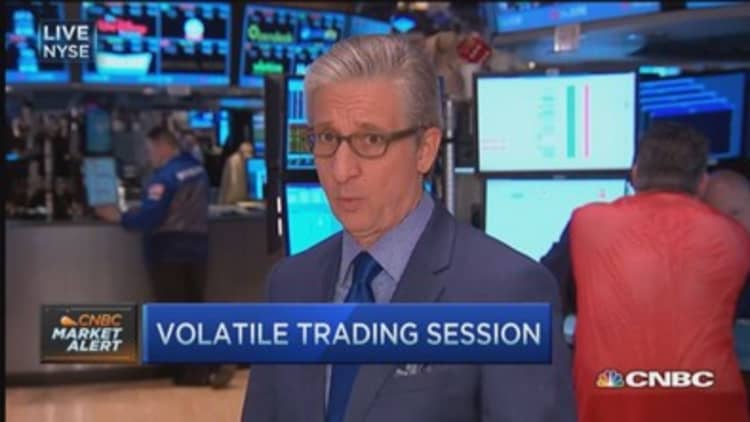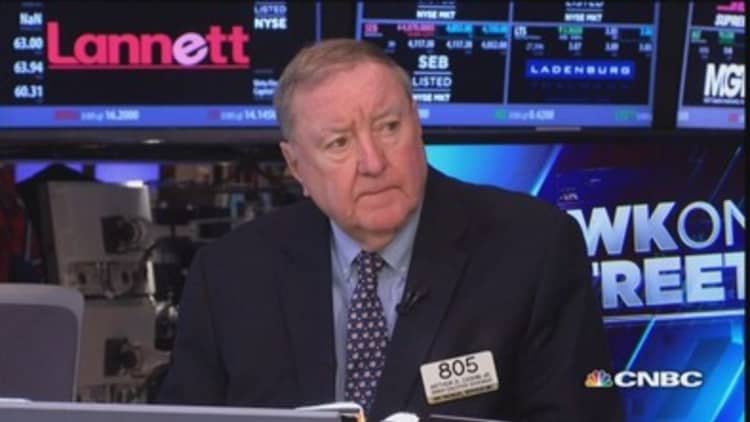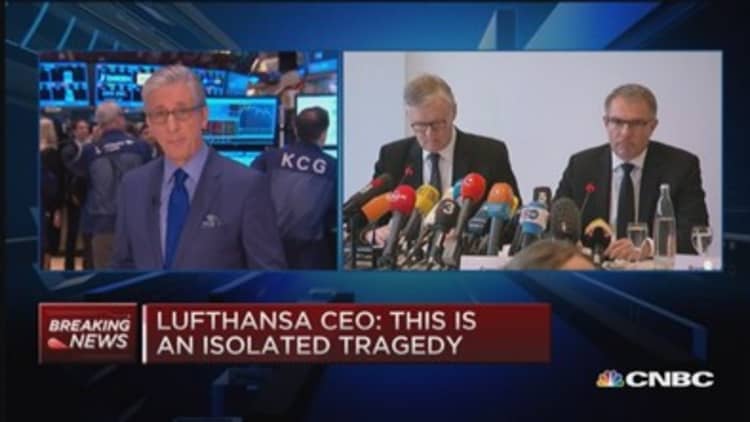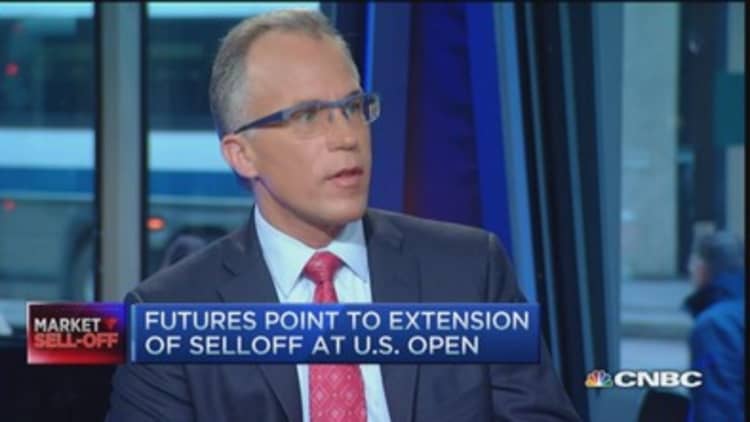



U.S. stocks closed mildly lower on Thursday as equities failed to shake off the losses of the last three days and investors weighed geopolitical events ahead of earnings season.
"I'm a little disappointed the market couldn't continue (higher) after last week," said Bruce Bittles, chief investment strategist at RW Baird. "It suggest something's not quite right."
He noted overwhelmingly bullish sentiment amid the recent selloff, which "suggests to me a tired market. It's a little complacency plus you've got first quarter earnings ahead.
Still, analysts were encouraged that the S&P 500 held above its 100-day moving average of about 2,040 and looked for the index to break upper resistance.
We "got down to the 100-day moving average on the S&P 500 (and) triggered that (bounce) and that level has held," said Robert Pavlik, chief market strategist at Boston Private Wealth, noting the next resistance level is 2,068. "I'm cautious on this bounce. In the overall order of things I think the market is trying to consolidate" ahead of earnings season.
Stocks attempted to hold slight gains in afternoon trade, recovering from an initial drop in the open that sent the Dow Jones industrial average more than 100 points lower and the Nasdaq off 1 percent.
"If the market can turn around here and turn positive on the day, then there's likely enough pent-up buying pressure to push the S&P back up toward the 2,073 level (which has been a pivotal point for several months)," Jeff Clark, analyst at Stansberry Research, said earlier. "I'm not saying that's going to happen in the next day or so. But, there is the potential for it to happen."
Read MoreReversal today? If so, it could be temporary
The iShares Nasdaq Biotechnology ETF closed 0.14 percent lower after struggling for direction throughout the day. The sector led the recent selloff by falling close to its 50-day moving average.
Jeffrey Loo, biotech analyst at S&P Capital IQ, said that "overall the fundamentals of the sector (are) still pretty solid." He expects earnings growth over the next couple of years, although not as high as in 2014.
"The sales potential for drugs approved in 2013, 2014 are tremendous," he said, noting that tangible results are still 5 to 6 years out.
"The pullback is broad-based but really concentrated in high beta sectors (of) biotechs and semiconductors," said Katie Stockton, chief technical strategist at BTIG. "The good news is the pullback has not generated a lot of breakdown."
The Dow transports broke through its 200-day moving average but closed off lows, down 0.57 percent.
Read MoreBiotech woes: Deja vu all over again
Marc Chaikin, CEO of Chaikin Analytics, said the Dow transports are the greatest driver of the market decline, briefly breaking its 200-day moving average as Union Pacific led nearly all components lower.
"The Dow transports has broken down. It's made a series of five tops (and) failed to make a new high in March. It's broken down in an equivalency basis to October lows, where it tested a major level of support," Chaikin said.
BTIG's Stockton noted that the index has underperformed since March 17 and has "come down to significant support levels" that indicate a "long-term uptrend."
"Basically (the decline in stocks) is two factors. Continuation from yesterday and Yemen in focus," said Peter Cardillo, chief market economist at Rockwell Global Capital.
Oil rose as tensions intensified in the Middle East after Saudi Arabia and its Gulf Arab allies began a military operation in Yemen.
Crude oil futures settled at $51.43 a barrel, its highest level since March 4.
Read MoreIs Yemen the new catalyst for oil?
"I do believe this is a perfect excuse for this pullback to continue," Cardillo said. "Clearly we see that fear factor driving investors to lock in profits ahead of earnings season."
The stronger dollar and weaker global economy weighed on last quarter's reports and analysts expect greater earnings pressure in the next quarter.
"Certainly the pace of the strength of the dollar and the decline of oil is hard to digest all at once. I think we'll see some effects in the first quarter but they'll work their way through," said Jim Dunigan, chief investment officer at PNC Asset Management.
The U.S. dollar edged higher against major world currencies as the euro fell below $1.09.
Investors also continued to eye developments in the Germanwings airplane crash in Europe.
"I think we're just continuing in this vacuum of the market being a bit directionless," said Mark Luschini, chief investment officer at Janney Montgomery Scott, noting the lull in major corporate or central bank news.
The U.S. 10-year Treasury yield gained to trade at 2 percent.
Read MoreSuddenly, bonds don't look so safe.
U.S. jobless claims fell to a five-week low, pointing to a healthy and expanding labor market.
Initial claims for state unemployment benefits dropped 9,000 to a seasonally adjusted 282,000 for the week ended March 21, the Labor Department said on Thursday. That was the lowest level since mid-February.
"Bottom line, economic growth has clearly slowed but the labor market has been very stable as it should as we'll likely get a second-quarter growth rebound. The pace of firing's remain modest and labor market stats are lagging indicator anyway," Peter Boockvar, chief market analyst at The Lindsey Group, said in a note.
Philip Noftsinger, president of CBIZ Payroll, said that the United States is "really just now entering the first inning of small business hiring. There's a lot of optimism among small business owners. Wage growth will follow along with hiring trends (as there are) limited candidates to fill those positions."
The U.S. services sector expanded in March at its fastest pace since September, an industry report showed on Thursday.
Financial data firm Markit said its preliminary, or "flash,'' reading of its Purchasing Managers Index for the service sector rose to 58.6 in March from a final reading of 57.1 in February.
Little other data was expected Thursday, with the Kansas City Fed's manufacturing index for March posting a decline of 4, missing expectations for holding steady at a reading of 1—the lowest since 2013.
Federal Reserve policymaker Dennis Lockhart said on Thursday that economic growth in the first quarter looks very soft and that a rate hike should come in the middle of the year or later.
Another Fed official, James Bullard, said earlier that now may be a good time to start normalizing U.S. monetary policy, in a speech to an audience in Frankfurt.
The St. Louis Fed President said doing that would direct policy "appropriately for an improving economy over the next two years."
Major U.S. Indexes
Lululemon beat estimates by five cents with quarterly profit of 78 cents per share, with revenue essentially in line and same-store sales increasing by five percent. However, the athleticwear retailer's forecast for the current quarter is short of Street estimates.
Winnebago missed estimates by 8 cents with quarterly profit of 30 cents per share, with revenue also well below forecasts. The recreational vehicle maker said it was hurt by labor-related constraints and higher operating expenses, although it also said it was seeing its profit margins improve and expects positive cash flow during the second half of the year.
Read MoreEarly movers: LULU, SNDK, CAG, WGO, MCD, AXP & more
Apple and its Beats music service are working on a subscription streaming services that won't have a free tier, according to a story in the New York Times. Separately, Apple is planning an iPhone trade-in program in China, according to Bloomberg.
The Dow Jones industrial average closed down 40.31 points, or 0.23 percent, at 17,678.23, with American Express the greatest laggard and IBM leading seven blue chips higher.
The S&P 500 closed down 4.90 points, or 0.24 percent, at 2,056.15, with utilities leading eight sectors lower and materials and information technology the only sectors gaining.
Art Hogan, chief market strategist at Wunderlich Securities, said that with the S&P 500 breaking its 50-day moving average of 2,070 on Wednesday, the next level of support was 2,040.
"The S&P hasn't broken the 50-day without testing the 100-day," he said.
The Nasdaq Composite closed down 13.16 points, or 0.27 percent, at 4,863.36.
The CBOE Volatility Index (VIX), widely considered the best gauge of fear in the market, briefly spiked to near 19.
For every three decliners about two advanced on the New York Stock Exchange, with an exchange volume of 828 million and a composite volume of nearly 3.5 billion in the close.
Gold futures settled up $7.80 at $1,204.80 an ounce.
—Reuters and CNBC's Peter Schacknow contributed to this report.
On tap this week:
Thursday
Earnings: Gamestop, Restoration Hardware, Scholastic, Commercial Metals
Friday
Earnings: BlackBerry
6:30 am: Fed Vice Chairman Fischer speaks in Germany
8:30 am: Real GDP (Q4 third)
10:00 am: Consumer sentiment
10:00 am: Atlanta Fed President Dennis Lockhart in Detroit
3:45 pm: Fed Chair Janet Yellen on monetary policy in San Francisco, Q&A
More from CNBC.com:


